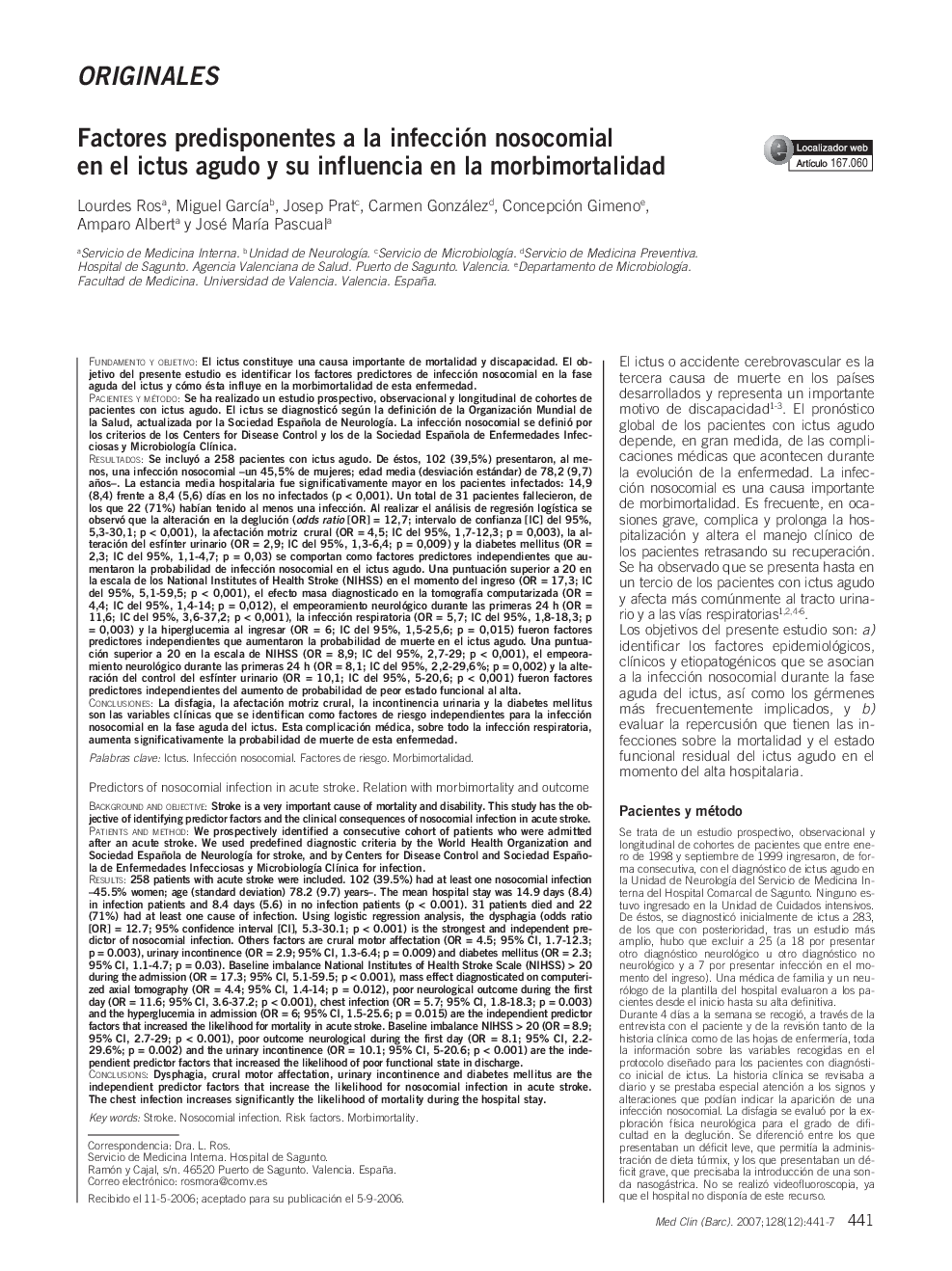| کد مقاله | کد نشریه | سال انتشار | مقاله انگلیسی | نسخه تمام متن |
|---|---|---|---|---|
| 3802830 | 1244837 | 2007 | 7 صفحه PDF | دانلود رایگان |

Fundamento y objetivoEl ictus constituye una causa importante de mortalidad y discapacidad. El objetivo del presente estudio es identificar los factores predictores de infección nosocomial en la fase aguda del ictus y cómo ésta influye en la morbimortalidad de esta enfermedad.Pacientes y métodoSe ha realizado un estudio prospectivo, observacional y longitudinal de cohortes de pacientes con ictus agudo. El ictus se diagnosticó según la definición de la Organización Mundial de la Salud, actualizada por la Sociedad Española de NeurologÃa. La infección nosocomial se definió por los criterios de los Centers for Disease Control y los de la Sociedad Española de Enfermedades Infecciosas y MicrobiologÃa ClÃnica.ResultadosSe incluyó a 258 pacientes con ictus agudo. De éstos, 102 (39,5%) presentaron, al menos, una infección nosocomial -un 45,5% de mujeres; edad media (desviación estándar) de 78,2 (9,7) años-. La estancia media hospitalaria fue significativamente mayor en los pacientes infectados: 14,9 (8,4) frente a 8,4 (5,6) dÃas en los no infectados (p < 0,001). Un total de 31 pacientes fallecieron, de los que 22 (71%) habÃan tenido al menos una infección. Al realizar el análisis de regresión logÃstica se observó que la alteración en la deglución (odds ratio [OR] = 12,7; intervalo de confianza [IC] del 95%, 5,3-30,1; p < 0,001), la afectación motriz crural (OR = 4,5; IC del 95%, 1,7-12,3; p = 0,003), la alteración del esfÃnter urinario (OR = 2,9; IC del 95%, 1,3-6,4; p = 0,009) y la diabetes mellitus (OR = 2,3; IC del 95%, 1,1-4,7; p = 0,03) se comportan como factores predictores independientes que aumentaron la probabilidad de infección nosocomial en el ictus agudo. Una puntuación superior a 20 en la escala de los National Institutes of Health Stroke (NIHSS) en el momento del ingreso (OR = 17,3; IC del 95%, 5,1-59,5; p < 0,001), el efecto masa diagnosticado en la tomografÃa computarizada (OR = 4,4; IC del 95%, 1,4-14; p = 0,012), el empeoramiento neurológico durante las primeras 24 h (OR = 11,6; IC del 95%, 3,6-37,2; p < 0,001), la infección respiratoria (OR = 5,7; IC del 95%, 1,8-18,3; p = 0,003) y la hiperglucemia al ingresar (OR = 6; IC del 95%, 1,5-25,6; p = 0,015) fueron factores predictores independientes que aumentaron la probabilidad de muerte en el ictus agudo. Una puntuación superior a 20 en la escala de NIHSS (OR = 8,9; IC del 95%, 2,7-29; p < 0,001), el empeoramiento neurológico durante las primeras 24 h (OR = 8,1; IC del 95%, 2,2-29,6%; p = 0,002) y la alteración del control del esfÃnter urinario (OR = 10,1; IC del 95%, 5-20,6; p < 0,001) fueron factores predictores independientes del aumento de probabilidad de peor estado funcional al alta.ConclusionesLa disfagia, la afectación motriz crural, la incontinencia urinaria y la diabetes mellitus son las variables clÃnicas que se identifican como factores de riesgo independientes para la infección nosocomial en la fase aguda del ictus. Esta complicación médica, sobre todo la infección respiratoria, aumenta significativamente la probabilidad de muerte de esta enfermedad.
Background and objectiveStroke is a very important cause of mortality and disability. This study has the ob-jective of identifying predictor factors and the clinical consequences of nosocomial infection in acute stroke.Patients and methodWe prospectively identified a consecutive cohort of patients who were admitted after an acute stroke. We used predefined diagnostic criteria by the World Health Organization and Sociedad Española de NeurologÃa for stroke, and by Centers for Disease Control and Sociedad Española de Enfermedades Infecciosas y MicrobiologÃa ClÃnica for infection.Results258 patients with acute stroke were included. 102 (39.5%) had at least one nosocomial infection â45.5% women; age (standard deviation) 78.2 (9.7) years-. The mean hospital stay was 14.9 days (8.4) in infection patients and 8.4 days (5.6) in no infection patients (p < 0.001). 31 patients died and 22 (71%) had at least one cause of infection. Using logistic regression analysis, the dysphagia (odds ratio [OR] = 12.7; 95% confidence interval [CI], 5.3-30.1; p < 0.001) is the strongest and independent predictor of nosocomial infection. Others factors are crural motor affectation (OR = 4.5; 95% CI, 1.7-12.3; p = 0.003), urinary incontinence (OR = 2.9; 95% CI, 1.3-6.4; p = 0.009) and diabetes mellitus (OR = 2.3; 95% CI, 1.1-4.7; p = 0.03). Baseline imbalance National Institutes of Health Stroke Scale (NIHSS) > 20 during the admission (OR = 17.3; 95% CI, 5.1-59.5; p < 0.001), mass effect diagnosticated on computerized axial tomography (OR = 4.4; 95% CI, 1.4-14; p = 0.012), poor neurological outcome during the first day (OR = 11.6; 95% CI, 3.6-37.2; p < 0.001), chest infection (OR = 5.7; 95% CI, 1.8-18.3; p = 0.003) and the hyperglucemia in admission (OR = 6; 95% CI, 1.5-25.6; p = 0.015) are the independient predictor factors that increased the likelihood for mortality in acute stroke. Baseline imbalance NIHSS > 20 (OR = 8.9; 95% CI, 2.7-29; p < 0.001), poor outcome neurological during the first day (OR = 8.1; 95% CI, 2.2-29.6%; p = 0.002) and the urinary incontinence (OR = 10.1; 95% CI, 5-20.6; p < 0.001) are the independient predictor factors that increased the likelihood of poor functional state in discharge.ConclusionsDysphagia, crural motor affectation, urinary incontinence and diabetes mellitus are the independient predictor factors that increase the likelihood for nosocomial infection in acute stroke. The chest infection increases significantly the likelihood of mortality during the hospital stay.
Journal: Medicina ClÃnica - Volume 128, Issue 12, March 2007, Pages 441-447